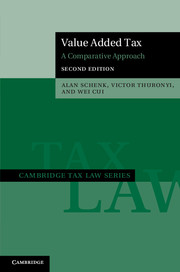Book contents
- Frontmatter
- Dedication
- Contents
- List of Tables and Charts
- List of Cases
- Preface to the Second Edition
- 1 Introduction
- 2 Consumption Tax Forms and Base Alterations
- 3 Varieties of VAT in Use
- 4 Registration, Taxpayer, and Taxable Activity
- 5 Taxable Supplies and Tax Invoices
- 6 The Tax Credit Mechanism
- 7 Introduction to Cross-Border Aspects of VAT
- 8 Timing and Valuation Rules
- 9 Zero-Rating, Exemptions, and Exempt Entities
- 10 VAT Evasion and Avoidance
- 11 Gambling and Financial Services (Other than Insurance)
- 12 Insurance
- 13 Real Property
- 14 An Anatomy of the Chinese VAT
- 15 Interjurisdictional Aspects
- Appendix VATs Worldwide
- Index
- References
4 - Registration, Taxpayer, and Taxable Activity
Published online by Cambridge University Press: 05 February 2015
- Frontmatter
- Dedication
- Contents
- List of Tables and Charts
- List of Cases
- Preface to the Second Edition
- 1 Introduction
- 2 Consumption Tax Forms and Base Alterations
- 3 Varieties of VAT in Use
- 4 Registration, Taxpayer, and Taxable Activity
- 5 Taxable Supplies and Tax Invoices
- 6 The Tax Credit Mechanism
- 7 Introduction to Cross-Border Aspects of VAT
- 8 Timing and Valuation Rules
- 9 Zero-Rating, Exemptions, and Exempt Entities
- 10 VAT Evasion and Avoidance
- 11 Gambling and Financial Services (Other than Insurance)
- 12 Insurance
- 13 Real Property
- 14 An Anatomy of the Chinese VAT
- 15 Interjurisdictional Aspects
- Appendix VATs Worldwide
- Index
- References
Summary
Introduction
Most VAT regimes require registered (or taxable) persons to file returns and remit tax. In most cases, a firm is required to register if it makes or expects to make at least the statutory minimum level of annual taxable sales in connection with its business or economic activity.
Not all sales by a person come within the scope of a VAT. For example, in most countries, an individual’s casual sales do not constitute taxable business activity and are not taxed. Hobbies and similar activities that do not rise to the level of a “business” generally are not taxed. An employee could be treated as a person rendering taxable services to her employer and therefore a VAT taxpayer, but no country has done this. This chapter discusses registration (including some required registration by nonresidents), who is liable for tax, and what economic activity subjects a seller to tax under various VAT regimes.
Registration
In General
Registration is part of a self-assessment VAT system that typically is reinforced with harsh civil and criminal penalties for noncompliance. Many VAT systems dei ne a taxable person subject to the VAT rules as a person who is registered (a registrant) or is required to register. Nonresidents without a fixed location in the country may be subject to a different set of rules. The registration requirement generally is imposed on a person or firm that makes at least a threshold amount of taxable sales.
- Type
- Chapter
- Information
- Value Added TaxA Comparative Approach, pp. 59 - 91Publisher: Cambridge University PressPrint publication year: 2015



